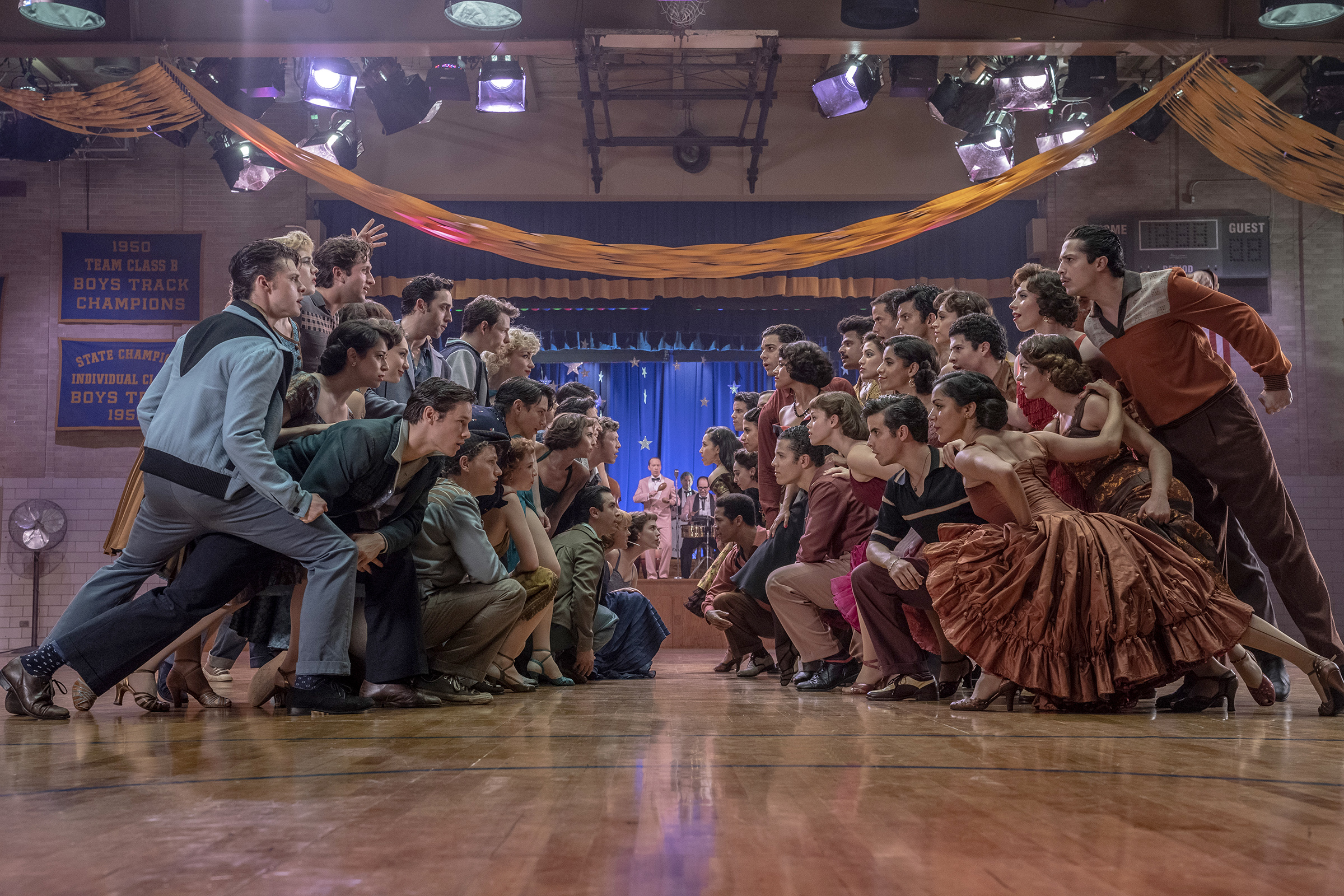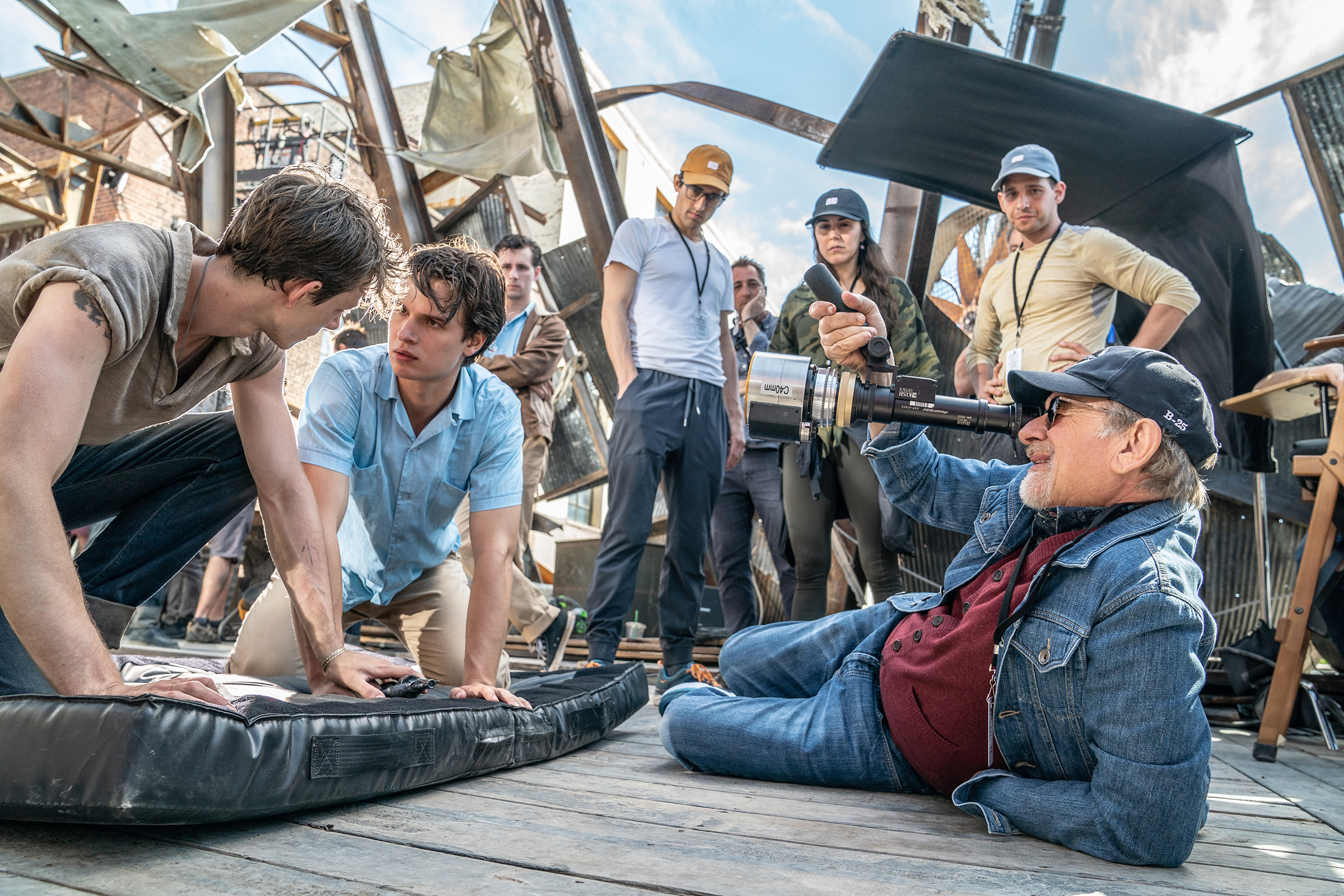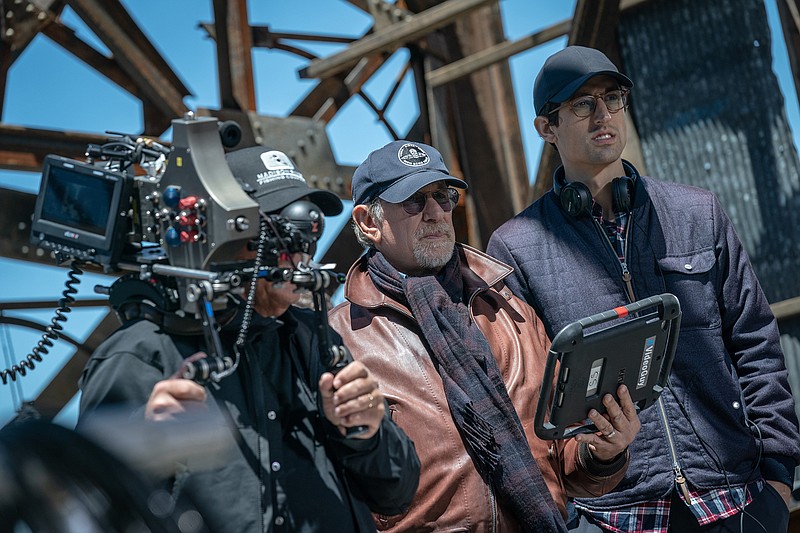At one point in the making of the new movie version of "West Side Story," Justin Peck, the film's choreographer, found himself careening around the studio with Steven Spielberg, pushing the director in a swivel chair so he could shoot the dancers with his phone.
That's when Peck realized he'd hurtled topsy-turvy into a crazy, wondrous universe. He'd also met a major goal: getting the Spielbergian operation to trust in the power of a wordless, poetic art form.
That, after all, was Peck's first task: convincing Spielberg, who'd never made a movie musical, that dance can tell a story all on its own. Without dialogue or special effects.
"Dance can be a foreign and strange means of communication to some people," Peck, 34, said in a recent interview over Zoom. "There was a process of working toward understanding it that Steven went through, and that we were in constant dialogue about. It was helping him understand the full range of what dance could express in a moment — that it was its own tool of language that could run throughout this film in the same way that words could or visuals could."
This came into focus when Peck and Spielberg were overseeing a rehearsal of the dance at the gym, an extended centerpiece that plunges moviegoers into the fiery emotions of the rival teenage gangs who frame the plot. It's where the Puerto Rican Sharks and the White, blue-collar Jets pour all their resentments, defiance and cultural pride into a dance battle that's inflamed by Leonard Bernstein's Latin jazz and a fiercely syncopated mambo.
Spielberg, says Peck, wasn't content to stand in a corner and watch. He wanted to immerse himself in the heart of the dance, to see how it looked through the camera lens.
"He was shooting it through his iPhone, trying to get inside the choreography," Peck says. "So I'm wheeling around this iconic American director on a computer chair as the dancers are doing the movement.
"It was," he adds, "a surreal, what-is-my-life moment."
Peck isn't new to moviemaking; he choreographed the 2018 film "Red Sparrow," starring Jennifer Lawrence as a ballerina turned spy. He also won a 2018 Tony award for his choreography in the Broadway revival of "Carousel." But working alongside such towering entertainment figures as Spielberg and screenwriter Tony Kushner, the acclaimed "Angels in America" playwright, Peck faced an intimidating challenge, to be sure. Add to that the little matter of choreographer Jerome Robbins, one of his personal heroes. Peck's job was to reimagine Robbins' famous dances, fixed in Broadway and movie history as some of the finest theatrical choreography ever.
His approach to the Robbins legacy, Peck says, was "not only being reverent of his work, but letting go of having to serve it. And to make my own mark in what I wanted it to be."
In other words, along with earning the filmmakers' trust, he had to trust himself.
Peck is speaking from his office at Lincoln Center, in the headquarters of New York City Ballet, where he has been the resident choreographer since 2014. He's wearing an oversize Yankees sweatshirt that engulfs his lanky dancer's frame. Dark hair in frothy waves flops over his horn-rimmed glasses.
COMMITTED ROBBINS FAN
He was a committed Robbins fan even before joining NYCB and performing his ballets. It was a family thing: Peck's grandfather, a civil rights activist who rode one of the first Freedom Riders buses into the South, was so moved by Robbins' 1957 Broadway production of "West Side Story" that he took his young son, Peck's future father, to see it.
Later, Peck's father and his mother, who had immigrated from Argentina to New York, shared the 1961 film with their son. They had moved from New York to Washington, where Peck was born, and then to San Diego, where he grew up. Peck doesn't remember how old he was when he saw the film with his family — "It came from a moment," he says, "when they were feeling nostalgic for New York City" — but seeing how the dancing deepened and developed the plot marked a moment of no return.
"I wanted to explore what that was," he says. "It had a huge influence in getting me to New York. I couldn't get to New York fast enough."
He got there at 15, arriving at the School of American Ballet, the training pipeline into New York City Ballet, the company that, not incidentally, was Robbins' choreographic home until his death in 1998. At 18, Peck joined NYCB as an apprentice; a year later he was in the corps de ballet. One of his first roles was Bernardo, leader of the Sharks, in "West Side Story Suite," a restaging of excerpts from the musical that Robbins created for the company in 1995.
"It was kind of daunting. I had to lead the group as a 19-year-old," Peck says. "But it was an organic connection with his work that's followed me my whole life."
Peck eventually rose to the rank of soloist, while at the same time making his own dances. (He retired from dancing in 2019.) He has created more than 20 ballets for NYCB alone, works that tend to play up the dancers' relationships as friends and colleagues. As in a Robbins ballet, Peck's dancers come across as real people — young, assertive, full of life. Performing so many of Robbins' ballets over the years helped teach him how to uncork a dancer's inner electricity.
Those ballets also freed Peck to walk his own path in the Spielberg "West Side Story."
"Having this long-term experience of watching (Robbins') work onstage and then dancing inside his works helped me understand them in a methodical way," Peck says. "Not like cramming for a project. It was over many years. And I suppose that led to this moment of taking on the daunting task of choreographing maybe one of the greatest pieces of dance theater of all time.
"It allowed me to let go of the conscious obligation of paying tribute to his work," he adds, "and just know that it was embedded in me. It's part of my own fabric."
 The gym scene is filmed in the new “West Side Story.” (Courtesy of 20th Century Studios)
The gym scene is filmed in the new “West Side Story.” (Courtesy of 20th Century Studios)
NAILING THE GYM SCENE
Peck quotes from Robbins, for example, in the dance-in-the-gym sequence when Tony, the sensitive, peacemaking Jet played by Ansel Elgort, meets Rachel Zegler's Maria, sister to Shark leader Bernardo.
It's a counterpoint to all the spinning kinetic fury and slashing lines of the gang confrontation in the gym, which involved "hundreds of people and very precise timing to pull off," Peck says. The camera zeros in on the Jets as they enter, swings low over the floor (with dancing Jets snaking under cable wires) and circles around to capture the Sharks' reactions. "When we got that shot, Steven and I jumped out of our chairs, freaking out and high-fiving like we were 5-year-olds."
Yet the quieter love-at-first-sight moment required a simpler approach. Peck decided to honor what Robbins had devised, with Tony and Maria locking eyes, reaching their arms out and slowly circling each other, as if caught in the gradual, inexorable pull of a whirlpool.
"It was too perfect," says Peck, "to not include. They're communicating with their movement and a physicality that comes from a deeper place within. It's the first thing that binds them. That's what makes us understand their chemistry — it's their dancing. It's this transcendent means of expression."
"Let's lean into that more," he says he told Spielberg. "And for someone who's never done a dance musical, there's a process to finding the trust in that. But I'm grateful he did trust that."
David Alvarez, who plays Bernardo, says Peck has an uncanny ability to highlight the unique talents of each dancer. "He studies you as a dancer and as a person," Alvarez says, "and finds what your strengths are and makes sure you can shine through those strengths."
Alvarez, one of the original Billys in "Billy Elliot the Musical," appreciated that because he hadn't danced in years before this film came along.
"I was rusty when I came into the audition process," he says. "So Justin was trying to figure out what I could do that was special, and right off the bat he knew it was my jumps, my turns, my double tours. He knew they'd be powerful on the screen, and I'm only shining because of him."
GIVING DUE CREDIT
Peck credits Kushner's freehanded treatment of the story with inspiring him to envision the dance numbers in new ways. Kushner, he says, "applied his own imagination. It was a philosophical blueprint."
It was Kushner's idea to place the tension-filled "Cool" scene, where the Jets squeeze down their hotheaded impulses, near the middle of the movie, before the fatal fight with the Sharks. (In the 1961 film, it comes after the fight, as a way for the surviving Jets to focus their grief.) Kushner's idea makes the "Cool" number about gun violence, Peck says, as Tony tries to persuade Jets leader Riff — the astonishingly quicksilver Mike Faist — not to bring bullets to the knife fight. The dancing spills across a dilapidated ferry terminal on the water that was specially constructed in an abandoned parking lot in Brooklyn. It's such a sprawling number that Peck couldn't find a studio big enough for rehearsals and had to create it in sections, finally putting it together on location.
"We were all nervous about it," Peck says. "It was one of the first things we filmed, and one of the more radical things."
Peck's work puts a dangerous, violent twist on virtuoso dance moves — Faist corkscrewing into the air, the Jets skidding down ramps and Elgort, a former ballet student at SAB, rocketing skyward with the rest of them. The choreographer has high praise for the dancers, all of different abilities and backgrounds. One, Harrison Coll, is from NYCB; others have made their mark on Broadway and elsewhere. Peck and his two associate choreographers — his wife, former ballerina Patricia Delgado, and dancer Craig Salstein — made sure the cast took a dance class together every day, as in a dance company, including Elgort, the film's biggest star.
 Steven Spielberg (far right) and Justin Peck (center, wearing a cap and glasses) work on set with actors Mike Faist (far left) who plays Riff and Ansel Elgort (center left) who plays Tony in “West Side Story.” (Courtesy of Walt Disney Studios)
Steven Spielberg (far right) and Justin Peck (center, wearing a cap and glasses) work on set with actors Mike Faist (far left) who plays Riff and Ansel Elgort (center left) who plays Tony in “West Side Story.” (Courtesy of Walt Disney Studios)
NO BODY DOUBLES
It's a great point of pride, Peck says, that there were no dance doubles or body doubles. (A few doubles are credited, he says, but that's because they were obliged to have them on standby for the underage actors, and they were never used.)
"No body doubling, no face replacement, no cutting away to hide anything," he says with a wide smile. "It's all very authentically danced. We had to fight so hard for that and make sure everyone was on the level to perform that way so they didn't feel exposed."
In "Red Sparrow," for instance, Lawrence's ballet scenes were doubled by American Ballet Theatre star Isabella Boylston. That's the industry trend. Peck preferred to cast "real standouts."
"We had to find the cast that can do right by the legacy of 'West Side Story,'" he says. "The work is only as good as those who interpret it."
It's clear that making this film jazzed him up for more.
"I do feel like I really caught the bug," he says. "My goal, as I think and dream, would be to make my own film, and approach it from a dancemaker's point of view, as Jerome Robbins and Bob Fosse have done.
"It's a miracle whenever a film is made," he says with a laugh. "So I'll just put that into the universe."
